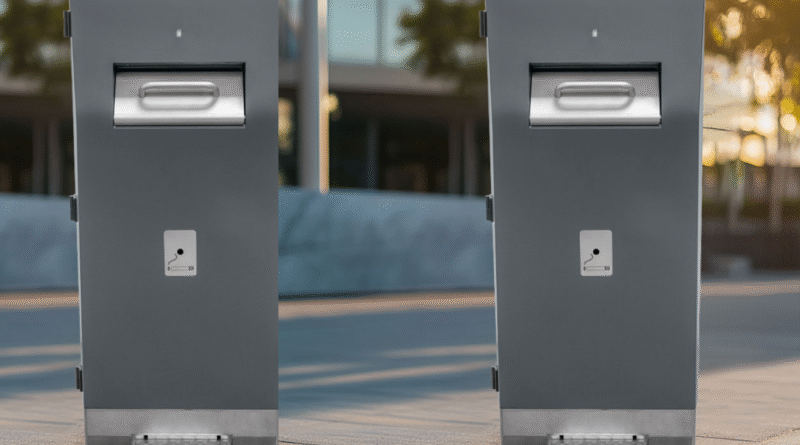Smart Bins: How IoT is Revolutionizing Waste Management in 2025
Introduction
Picture a city where garbage trucks only make rounds when absolutely necessary. Imagine public bins that never overflow, and neighborhoods that remain spotless year-round. This vision is no longer a fantasy—thanks to the Internet of Things (IoT), smart bins are reshaping urban waste management in 2025. This blog explores how IoT-enabled smart bins are making our cities cleaner, greener, and more efficient, while delivering real benefits to residents, city authorities, and the environment.
The Evolution of Waste Management
Traditionally, waste management has been a reactive process. Bins are collected on a fixed schedule, regardless of whether they are full or nearly empty. This approach can lead to overflowing bins, unnecessary pickups, and wasted resources. Inefficient waste collection not only strains city budgets but also contributes to urban blight and environmental pollution.
As cities grow and populations rise, the challenges of waste management multiply. The need for more effective solutions has never been greater. Enter the era of smart technology—where data, connectivity, and automation are transforming every aspect of urban life, including how we handle waste.
What Are Smart Bins?
Smart bins are next-generation waste containers equipped with sensors, connectivity, and sometimes even compacting mechanisms. These bins are part of the broader IoT ecosystem, which connects everyday objects to the internet, enabling them to send and receive data.
Key Features of Smart Bins
Fill-Level Sensors: Detect how full the bin is at any given time.
Temperature and Gas Sensors: Monitor for unusual conditions, such as fires or hazardous gas buildup.
Connectivity: Use wireless networks (like LTE-M, NB-IoT, or Wi-Fi) to transmit data.
Compacting Mechanisms: Some smart bins compress waste, increasing capacity and reducing collection frequency.
Solar Panels: Power sensors and compactors, making the bins self-sufficient.
How IoT Powers Smart Waste Management
IoT technology is the backbone of smart bins. It enables real-time monitoring, data collection, and automated alerts, creating a more responsive and efficient waste management system.
Real-Time Monitoring
Smart bins continuously monitor their fill levels and environmental conditions. This data is transmitted to a central management platform, where it can be analyzed and acted upon. City officials and waste management teams can see at a glance which bins need attention and which do not.
Optimized Collection Routes
With real-time data, waste collection routes can be dynamically adjusted. Instead of following a fixed schedule, trucks are dispatched only when bins are full. This optimization reduces fuel consumption, vehicle wear and tear, and labor costs. It also minimizes traffic congestion and emissions from collection vehicles.
Preventing Overflow and Hazards
Overflowing bins are a common sight in many cities, especially during peak times or after public events. Smart bins help prevent this by alerting authorities before they reach capacity. Some bins also monitor for hazardous conditions, such as fires or gas leaks, adding an extra layer of safety for urban environments.
Data-Driven Decision Making
The data collected by smart bins provides valuable insights for city planners. By analyzing trends in waste generation, authorities can identify hotspots, plan infrastructure improvements, and allocate resources more effectively. This data can also inform public awareness campaigns and recycling initiatives.
The Human Impact of Smart Bins
While the technical benefits of smart bins are impressive, their real value lies in the positive impact on people’s lives.
Cleaner, Healthier Cities
Clean streets and public spaces are essential for quality of life. Overflowing bins attract pests, create unpleasant odors, and contribute to litter. Smart bins help maintain cleanliness by ensuring timely collections, reducing the risk of overflow and its associated problems.
Improved Public Health
Uncollected waste can pose health risks, especially in densely populated areas. By preventing overflow and monitoring for hazardous conditions, smart bins contribute to a healthier urban environment. This is particularly important in the context of infectious diseases and air quality.
Enhanced Citizen Experience
Residents appreciate living in clean, well-maintained neighborhoods. Smart bins contribute to a sense of pride and community, making cities more attractive places to live, work, and visit. They also reduce the burden on local authorities, allowing them to focus on other important services.
Environmental Benefits
The environmental advantages of smart bins are significant and align with global sustainability goals.
Reduced Carbon Footprint
By optimizing collection routes and reducing unnecessary pickups, smart bins help lower greenhouse gas emissions from waste collection vehicles. This is a crucial step toward achieving net-zero carbon targets for cities.
Support for Circular Economy
Smart bins are part of a broader shift toward a circular economy, where resources are reused and recycled instead of ending up in landfills. By improving waste sorting and collection, smart bins make it easier to recover valuable materials and reduce the environmental impact of waste.
Energy Efficiency
Solar-powered smart bins and energy-efficient sensors ensure that the technology itself is sustainable. These bins operate independently of the grid, reducing energy consumption and operational costs.
Case Studies: Smart Bins in Action
To illustrate the real-world impact of smart bins, let’s look at a few examples from around the world.
Singapore
Singapore, known for its smart city initiatives, has deployed smart bins in high-traffic areas such as shopping districts and public transport hubs. These bins use sensors to monitor fill levels and compact waste, reducing collection frequency by up to 70%. The city has reported cleaner streets, lower operational costs, and positive feedback from residents and visitors.
Barcelona
Barcelona has integrated smart bins into its broader IoT infrastructure. The bins communicate with a central platform that coordinates waste collection with other city services. This integration has led to more efficient resource allocation and a noticeable improvement in urban cleanliness.
New York City
In New York, smart bins have been piloted in busy neighborhoods and parks. The bins use solar power and compacting mechanisms to increase capacity and reduce overflow. Early results show a significant reduction in litter and a more pleasant environment for residents and tourists.
The Future of Smart Waste Management
As technology continues to evolve, so too will the capabilities of smart bins. Here are some trends to watch in the coming years.
Integration with AI and Machine Learning
Artificial intelligence (AI) and machine learning can analyze data from smart bins to predict waste generation patterns. This predictive capability allows cities to anticipate surges in waste (such as after festivals or public events) and adjust collection schedules accordingly.
Blockchain for Transparency
Blockchain technology can be used to create transparent, tamper-proof records of waste collection and disposal. This ensures accountability and helps cities meet regulatory requirements.
Expanded Use Cases
Smart bins are not limited to urban areas. They can be deployed in parks, campuses, industrial sites, and even remote locations. As the technology becomes more affordable, its adoption is expected to grow worldwide.
Citizen Engagement
Mobile apps and gamification can encourage residents to participate in waste management. For example, apps can provide real-time feedback on recycling efforts, offer rewards for correct disposal, and educate users about sustainability.
Challenges and Considerations
While smart bins offer many benefits, there are also challenges to consider.
Initial Investment
The upfront cost of deploying smart bins can be significant. However, the long-term savings in operational costs and environmental benefits often justify the investment.
Data Security and Privacy
As with any IoT device, data security is a concern. Cities must ensure that the data collected by smart bins is protected and used responsibly.
Maintenance and Reliability
Smart bins require regular maintenance to ensure sensors and connectivity remain functional. Cities must have the infrastructure and expertise to support these systems.
Conclusion
The rise of IoT-enabled smart bins is a game-changer for urban waste management in 2025. By leveraging real-time data, connectivity, and automation, smart bins are making our cities cleaner, healthier, and more sustainable. They optimize collection routes, reduce operational costs, and support environmental goals—all while improving the quality of life for residents.
As technology continues to advance, the potential for smart waste management is limitless. Cities that embrace these innovations will lead the way toward a smarter, greener future. The next time you toss something into a public bin, take a moment to appreciate the technology that keeps your city clean—smart bins are not just containers, but the brains behind a cleaner, more efficient urban environment.




